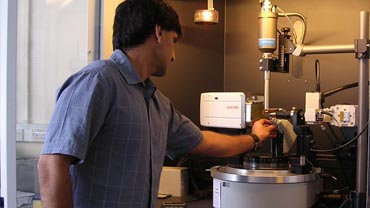School of Chemistry
X-ray crystallography
 X-ray crystallography is a technique used to establish molecular structure by interpretation of diffraction data when a single crystal is placed in an X-ray beam. Provided the sample can be obtained as a single crystal of suitable size, the results reveal the 3D molecular structure and the relative orientation of groups, together with the intra- and intermolecular bond distances and angles.
X-ray crystallography is a technique used to establish molecular structure by interpretation of diffraction data when a single crystal is placed in an X-ray beam. Provided the sample can be obtained as a single crystal of suitable size, the results reveal the 3D molecular structure and the relative orientation of groups, together with the intra- and intermolecular bond distances and angles.
The service is also available on a contractual basis, please contact Kuldip Singh for more details.
Bruker APEX Smart 2000 Diffractometer
- Location: Second floor George Porter Building, University Road end, near to lift, Room 2.15
- Primary use: Chemistry research
About
The department has a Bruker APEX 2000 diffractometer, which has a 4k CCD detector, allowing rapid data acquisition for most samples. The sensitive detector also makes it possible to collect data from samples of smaller crystals (<0.1mm). Samples are routinely cooled to 150K using an Oxford Cryostream cooler. The diffractometer usually operates with Mo- Ka radiation that is ideal for small molecule crystallography. Typical molecular determinations have between 10 and 200 unique non-hydrogen atoms.